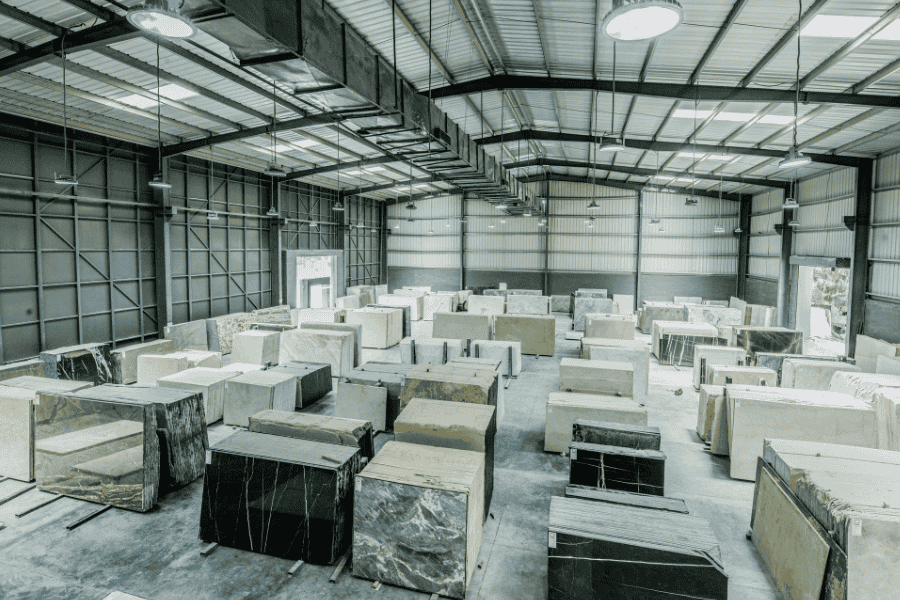One-Stop Warehouse Solutions vs Traditional Multi-Vendor Logistics: The Future of Stone Industry Supply Chains
1. Understanding One-Stop Warehouse Solutions and Traditional Logistics
One-Stop Warehouse Solutions
-
Centralized model integrating storage, inventory management, value-added services, and export logistics.
-
Ideal for stone exporters handling heavy slabs, tiles, and cut-to-size products.
-
Benefits: seamless coordination, reduced damage risk, single invoicing, faster customs clearance.

one-stop warehouse solutions
Traditional Multi-Vendor Logistics
-
Separate vendors for warehousing, packaging, transport, and documentation.
-
Often used by smaller distributors or when specific services are cheaper locally.
-
Benefits: flexibility in vendor choice, potential cost negotiation, niche expertise.
Quick Comparison Table
| Feature | One-Stop Warehouse Solutions | Traditional Multi-Vendor Logistics |
|---|---|---|
| Coordination | Single provider, high efficiency | Multiple vendors, risk of miscommunication |
| Inventory | Centralized tracking systems | Fragmented visibility |
| Stone Safety | Specialized handling reduces breakage | Higher risk due to multiple transfers |
| Cost Structure | Transparent, bundled pricing | Potentially lower short-term costs |
| Scalability | Easily expandable for global markets | Slower, vendor-dependent |
2. Global Relevance for the Stone Industry
Europe
-
Stricter EPR packaging rules and sustainability reporting make one-stop warehouse solutions appealing for marble and granite exporters.
-
Germany’s LUCID Packaging Register demands traceability — centralized providers simplify compliance.
Middle East (UAE, Saudi Arabia)
-
Demand for premium marble slabs in Dubai and Riyadh requires reliable stone warehouse management with climate control.
-
One-stop providers integrate bonded warehouses with port access.
North America
-
Importers prefer vendors who guarantee damage-free moving and real-time tracking.
-
Stone buyers value providers who handle slab storage rack systems and delivery in one chain.
3. Certification and Standards in Warehouse Management
-
ISO 9001 (Quality Management): proves operational consistency.
-
ISO 28000 (Supply Chain Security): required for sensitive shipments.
-
C-TPAT (US Customs Trade Partnership): one-stop providers often pre-certified, reducing clearance delays.
Expert Quote:
“Stone exporters underestimate the risk of fragmented logistics. In 2024, over 30% of breakage claims came from multi-vendor handling. Centralized one-stop warehouse solutions are no longer just an option; they’re becoming an industry standard.”
— Dr. Peter Lang, Supply Chain Researcher, Fraunhofer Institute 【Fraunhofer 2024 Report】
4. Real-World Application Scenarios
Case 1: EU Market Entry for Marble Tiles
An Italian distributor consolidated suppliers into a one-stop warehouse solution in Rotterdam. Result: customs clearance time dropped by 40%, with fewer slab damages.
Case 2: Middle East Exhibition Logistics
A Turkish quarry used traditional multi-vendor logistics for Dubai Stone Show. Coordination issues led to missing display slabs. They later switched to one-stop service providers with bonded warehousing.
Case 3: US Importer of Quartzite Slabs
An American importer insisted on real-time inventory control. Their Chinese supplier adopted one-stop warehouse solutions, using smart slab storage racks integrated with ERP systems, improving client trust and order repeat rates.

stone one-stop warehouse solutions
5. Expert Analysis: Pros and Cons
One-Stop Warehouse Solutions
✅ Seamless coordination
✅ Lower breakage and claims
✅ Transparent compliance
❌ Less flexibility in switching vendors
Traditional Multi-Vendor Logistics
✅ Short-term cost flexibility
✅ Choice of niche experts
❌ Risk of communication breakdown
❌ Higher damage risk for stone slabs
6. Future Trends and Outlook
-
Digital Twin Warehousing: AI-enabled stone warehouse management with predictive analytics.
-
Sustainability Metrics: Exporters required to report carbon footprint per shipment.
-
End-to-End Visibility: Importers demand QR-coded slab handling systems.
-
Regional Hubs: China and Turkey will dominate one-stop bonded warehouses for global marble and granite.
Industry Reference: McKinsey’s 2025 Supply Chain Outlook notes that integrated models outperform fragmented ones by 22% in delivery reliability 【McKinsey 2025 Report】.
7. Frequently Asked Questions (FAQ)
Does one-stop warehousing cost more?
Not always. While bundled services may look higher, reduced breakage and customs delays often save money long-term.
Can small stone exporters use one-stop warehouse solutions?
Yes. Many providers offer flexible contracts tailored to SMEs.
Which markets demand certified warehouse providers?
EU, US, and Middle East importers increasingly require ISO and customs security certifications.
What if I already have strong vendor relationships?
Traditional models may still work, but centralized solutions can complement peak-season exports.

One-stop storage solution for small warehouses
📚 References
-
McKinsey & Company – The State of Supply Chain 2025.
👉 https://www.mckinsey.com/ -
Fraunhofer Institute for Material Flow and Logistics – Global Supply Chain Risk and Resilience Report 2024.
👉 https://www.iml.fraunhofer.de/ -
European Commission – Packaging and Packaging Waste Directive (94/62/EC).
👉 https://environment.ec.europa.eu/topics/waste-and-recycling/packaging-waste_en -
German LUCID Packaging Register – EPR and Packaging Compliance.
👉 https://www.verpackungsregister.org/ -
U.S. Customs and Border Protection (CBP) – C-TPAT: Customs Trade Partnership Against Terrorism.
👉 https://www.cbp.gov/ -
International Organization for Standardization (ISO) – ISO 9001 Quality Management Systems.
👉 https://www.iso.org/iso-9001-quality-management.html -
International Organization for Standardization (ISO) – ISO 28000 Supply Chain Security Management.
👉 https://www.iso.org/standard/44641.html -
Journal of Global Logistics – Rossi, E. Integrated vs Fragmented Logistics Models in International Trade, 2024.
-
UAE Federal Environment Agency – Single-Use Plastics Policy and Warehouse Regulations.
👉 https://www.ead.gov.ae/ -
World Bank – Global Trade Logistics Performance Index 2023.
👉 https://lpi.worldbank.org/
The Future of Stone Logistics Is IntegratedThe comparison between one-stop warehouse solutions and traditional multi-vendor logistics reveals a clear trend: both models retain value, but the industry is shifting toward integration. For exporters of marble, granite, and quartzite, efficiency is no longer just about moving slabs—it is about compliance, transparency, and global buyer trust. One-stop warehouse models deliver lower breakage rates, faster customs clearance, and real-time digital visibility, while traditional multi-vendor approaches may still work in cost-sensitive or localized markets.
Expert Interpretation:
“The transition to one-stop warehouse solutions is not merely a cost decision. It is a strategic response to global compliance pressures and buyer expectations. As markets like the EU and Middle East demand traceability, centralized warehouse providers are setting a new industry standard.”
— Prof. Elena Rossi, University of Milan 【Journal of Global Logistics, 2024】
Expert Argument with Evidence:
A McKinsey 2025 report confirms that integrated warehouse models improve on-time delivery by 22% compared to fragmented supply chains 【McKinsey Supply Chain Outlook, 2025】. This proves that logistics integration is not only operationally superior but strategically necessary for exporters aiming at long-term competitiveness.
In 2025 and beyond, the future of stone logistics is clear: exporters who embrace one-stop warehouse solutions will enjoy faster growth, fewer risks, and stronger buyer confidence—while those clinging to traditional multi-vendor setups may struggle to keep up with global standards.
Previous News
Top 7 Advantages of Using Narrow Aisle Racking ...Next News
One-Stop Warehouse vs Decentralized Storage: Fi...Share:




